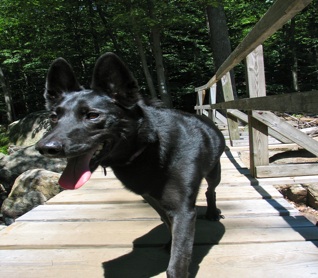Sheryl Matthys, The Dog Expert & Kim Boatman
6/2010
Leashes and Lovers and Outdoor Bound have offered HIKE AND HOUND for a few years now. While these outdoor excursions are fun for both human and canine, hiking with dogs takes some planning and thought.
The following checklist will help keep your hike from turning into a misadventure.
1. Understand your dog’s capabilities.
Your dog’s breed, size, medical condition and age all play a role in the distance and difficulty of a hike. A Labrador can go all day, whereas a smaller dog can go for an hour. Medium- to large-sized dogs should be able to hike at least a couple of hours in a moderate climate, adds Dr. Greg Martinez, a veterinarian who hikes and runs with dogs.
2. Recognize when your dog tires.
How will you know when your dog has had enough? “Almost all dogs want to be ahead of you, with you watching its tail wag,” says Gelbert. “If your dog isn’t eager to be ahead of you, it’s an indication that it’s time to rest.”
3. Carry plenty of water.
Dogs can overheat faster than we do, notes Martinez. It’s important to carry enough chilled water for your dog to drink — and to even douse your dog with a splash on a hot day. Your dog can be trained to carry its own water since canines adjust easily to wearing travel packs. Before your journey, have your dog practice walking around the house with an empty pack, then add toilet paper rolls for weight. And never let your dog drink from a stream or lake. Even a fast-flowing mountain stream is going to have bacteria that can cause diarrhea.
4. Know environmental risks.
As you plan a hike, research potential threats to your dog. Make sure your dog is protected against potentially deadly parasites before you leave home. Mosquitoes are prevalent in some areas, and ticks are ubiquitous in others. As for heartworm, protect your dog against ticks but still inspect for ticks after your hike. It’s a good idea to pack a tick comb for that task. If you’re hiking in rattlesnake habitat, ask your veterinarian about a vaccine that protects against rattlesnake venom, advises Martinez.
5. Protect your dog’s paws.
Dogs are often left hiking over rough surfaces with tender paws. Notice the terrain and consider its effect on your dog’s paw pads. It’s easy for your dog to burn its pads on hot surfaces or develop sores in between its toes when hiking on a rocky trail.
If your dog suffers even a minor pad cut, it may bleed profusely. Wrapping it lightly with medical wrapping tape should help. A small tube of Krazy Glue can also be used to close minor wounds. Make sure you check your dog’s paws for mud, debris and even ice that might accumulate between pads.
6. Respect wildlife and other hikers.
Keeping your dog with you makes a hike better for you, your dog, wildlife and other hikers who might not be dog lovers. Letting your dog wander off trail poses risks to both your pal and the environment.
If you keep the above checklist in mind, chances are your dog will be waiting eagerly by the front door next time you pull out your backpack, boots and trail map.
CLICK HERE to get dates for Leashes and Lovers Hike and Hound events

